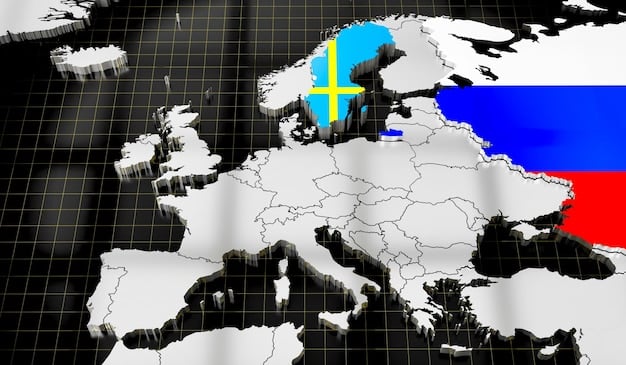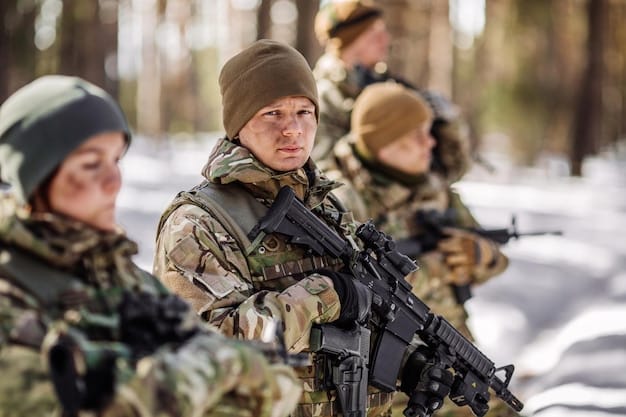Shifting Alliances in Eastern Europe: Impact on US Interests

Shifting alliances in Eastern Europe significantly impact US national interests by influencing regional stability, trade, and security, necessitating a strategic recalibration of US foreign policy.
The geopolitical landscape of Eastern Europe is in constant flux, with shifting alliances posing significant challenges and opportunities for the United States. Understanding how the shifting alliances in Eastern Europe affect US national interests is crucial for shaping effective foreign policy and maintaining global stability.
Understanding the Geopolitical Significance of Eastern Europe
Eastern Europe serves as a critical bridge between the West and Russia, making it a region of immense geopolitical importance. Its strategic location, coupled with a complex history of shifting alliances, directly impacts US national interests.
The region’s significance stems from its role as a buffer zone, an energy corridor, and a battleground for competing political ideologies. Any shift in alliances within Eastern Europe can have far-reaching consequences for regional stability and global power dynamics.
Historical Context of Alliances in Eastern Europe
The historical context of Eastern Europe is steeped in centuries of shifting allegiances, influenced by powerful empires and regional rivalries. Understanding this history is crucial to grasping the current dynamics.
- The influence of the Soviet Union during the Cold War shaped many of the existing alliances and divisions.
- The collapse of the Soviet Union led to a period of realignment, with many countries seeking closer ties with the West.
- Ongoing tensions between Russia and the West continue to drive alliance formations in the region.

Current Key Players and Alliances
Several key players and alliances define the current geopolitical landscape of Eastern Europe. These include NATO, the European Union, and various bilateral agreements.
NATO’s eastward expansion has been a significant development, drawing several Eastern European countries into the Western security framework. However, Russia’s influence remains strong in certain areas, leading to complex and sometimes conflicting alliances.
In conclusion, Eastern Europe’s geopolitical significance lies in its strategic location and complex history of shifting alliances, which directly affects US national interests by influencing regional stability and global power dynamics.
The Impact of Russia’s Influence on Eastern Europe
Russia’s influence in Eastern Europe is a critical factor shaping the region’s geopolitical landscape. Moscow’s efforts to maintain its sphere of influence directly challenge US national interests.
Russia employs a variety of tactics, including economic coercion, disinformation campaigns, and military intervention, to exert influence over Eastern European countries. This influence aims to undermine Western alliances and maintain a buffer zone along its borders.
Economic Coercion and Energy Dependence
Economic coercion and energy dependence are key tools in Russia’s arsenal. By controlling energy supplies and manipulating trade relationships, Moscow can exert significant pressure on Eastern European countries.
- Russia uses its control over natural gas pipelines to influence energy policies and create dependencies.
- Economic sanctions and trade restrictions are employed to punish countries that align too closely with the West.
- Investment in key infrastructure projects is used to gain political leverage and control over strategic assets.
Disinformation Campaigns and Cyber Warfare
Disinformation campaigns and cyber warfare are increasingly used by Russia to destabilize Eastern European countries and undermine trust in Western institutions.
These campaigns aim to spread false narratives, sow discord, and influence public opinion. Cyber attacks target critical infrastructure and government institutions, disrupting services and undermining security.
Russia’s influence in Eastern Europe is a multi-faceted challenge that requires a comprehensive and coordinated response from the United States and its allies. This includes strengthening economic resilience, countering disinformation, and bolstering cyber defenses.
NATO’s Role in Counterbalancing Russian Influence
NATO plays a crucial role in counterbalancing Russian influence in Eastern Europe. The alliance provides a collective security framework that deters aggression and promotes stability.
NATO’s presence in Eastern Europe has increased in recent years, with enhanced military deployments, joint exercises, and infrastructure improvements. These measures aim to reassure allies and deter potential Russian aggression.
NATO’s Enhanced Forward Presence
NATO’s Enhanced Forward Presence (EFP) is a key component of its strategy to deter Russian aggression in Eastern Europe.
The EFP involves the deployment of multinational battlegroups to frontline states, including Poland, Lithuania, Latvia, and Estonia. These battlegroups serve as a tripwire force, signaling NATO’s commitment to defend its allies.

Strengthening Partnerships with Non-NATO Countries
NATO also works to strengthen partnerships with non-NATO countries in Eastern Europe, such as Ukraine and Georgia. These partnerships aim to enhance security cooperation and promote democratic reforms.
- NATO provides training and equipment to help these countries improve their military capabilities.
- Joint exercises and security dialogues enhance interoperability and build trust.
- NATO supports reforms aimed at strengthening democratic institutions and combating corruption.
In conclusion, NATO’s role in counterbalancing Russian influence is essential for maintaining stability and security in Eastern Europe. The alliance’s enhanced military presence and partnerships with non-NATO countries provide a strong deterrent against aggression and promote democratic values.
Economic Opportunities and Challenges for the US
Eastern Europe presents both economic opportunities and challenges for the United States. The region’s growing economies and strategic location make it an attractive market for US businesses, but political risks and corruption remain significant obstacles.
The US can benefit from increased trade and investment in Eastern Europe, supporting economic growth and creating jobs at home. However, navigating the complex political landscape and addressing corruption are essential for success.
Trade and Investment Opportunities
Several sectors offer promising trade and investment opportunities for US companies in Eastern Europe. These include technology, energy, infrastructure, and agriculture.
Eastern European countries are investing heavily in modernizing their infrastructure, creating demand for US expertise and technology. The region’s agricultural sector also presents opportunities for US exporters and investors.
Addressing Corruption and Political Risks
Corruption and political risks pose significant challenges for US businesses operating in Eastern Europe. Addressing these issues is essential for creating a level playing field and attracting foreign investment.
The US government can play a role in promoting transparency and good governance in Eastern Europe, working with local partners to combat corruption and strengthen the rule of law. Supporting independent media and civil society organizations is also crucial for promoting accountability and transparency.
Eastern Europe offers significant economic opportunities for the US, but these opportunities must be pursued strategically and with a clear understanding of the challenges. Addressing corruption and political risks is essential for unlocking the region’s full economic potential and promoting long-term stability.
The Role of the European Union
The European Union (EU) plays a significant role in shaping the political and economic landscape of Eastern Europe. EU membership offers Eastern European countries access to the single market, structural funds, and political integration.
The EU’s influence in Eastern Europe is multifaceted, encompassing economic development, regulatory alignment, and the promotion of democratic values. The EU serves as a powerful anchor for stability and reform in the region.
EU Membership and Accession Process
EU membership is a transformative process for Eastern European countries, requiring significant reforms in areas such as governance, rule of law, and economic policy.
- Accession to the EU involves meeting strict criteria related to democracy, human rights, and economic stability.
- EU membership provides access to structural funds that support infrastructure development and economic growth.
- EU membership also entails adopting EU laws and regulations, which promote transparency and accountability.
Challenges and Opportunities for EU Enlargement
EU enlargement faces several challenges, including concerns about the EU’s capacity to absorb new members and the political will of member states to support further enlargement.
Despite these challenges, EU enlargement remains a powerful tool for promoting stability and reform in Eastern Europe. The prospect of EU membership incentivizes countries to undertake difficult reforms and align themselves with EU values.
The EU plays a critical role in shaping the political and economic landscape of Eastern Europe, offering a path to integration, stability, and prosperity. The EU’s influence extends to promoting democratic values, regulatory alignment, and economic development, making it a key partner for the United States in the region.
Future Scenarios and Implications for US Policy
Several future scenarios could unfold in Eastern Europe, each with significant implications for US policy. Understanding these potential trajectories is crucial for developing effective strategies to protect US national interests.
These scenarios range from continued regional instability to increased integration with the West. US policy must be flexible and adaptable to respond to these evolving dynamics.
Scenario 1: Continued Regional Instability
Continued regional instability could result from ongoing tensions between Russia and the West, unresolved conflicts, and internal political divisions within Eastern European countries.
This scenario would require the US to maintain a strong military presence in the region, support allies, and work to de-escalate tensions. Diplomatic engagement and economic assistance would be essential for preventing further deterioration.
Scenario 2: Increased Integration with the West
Increased integration with the West could occur if Eastern European countries continue to strengthen their ties with the EU and NATO, consolidate democratic institutions, and implement economic reforms.
This scenario would create new opportunities for US trade and investment, strengthen alliances, and promote stability in the region. The US would need to support these efforts through diplomatic engagement, economic assistance, and security cooperation.
In conclusion, the future of Eastern Europe is uncertain, but the US must be prepared to respond to different scenarios. Whether the region experiences continued instability or increased integration with the West, US policy must be guided by a commitment to promoting stability, security, and democratic values.
| Key Point | Brief Description |
|---|---|
| 🇷🇺 Russia’s Influence | Russia uses economic and political leverage to maintain influence in Eastern Europe, challenging US interests. |
| 🛡️ NATO’s Role | NATO’s presence and partnerships in Eastern Europe serve as a crucial counterbalance to Russian aggression. |
| 💼 Economic Opportunities | Eastern Europe offers trade and investment opportunities for US companies, but corruption remains a challenge. |
| 🇪🇺 EU’s Influence | The EU promotes economic and political integration in Eastern Europe, influencing stability and reforms. |
Frequently Asked Questions
▼
Eastern Europe is a crucial buffer zone between the West and Russia, impacting regional security, energy supplies, and political ideologies. Its stability directly affects US national interests.
▼
Russia employs economic coercion, disinformation campaigns, and military pressure to sway Eastern European nations, attempting to undermine Western alliances and maintain regional control.
▼
NATO deters Russian aggression, promotes stability, and strengthens partnerships with Eastern European countries. Its Enhanced Forward Presence (EFP) is a key deterrent measure.
▼
Key sectors include technology, energy, infrastructure, and agriculture. However, US businesses must navigate corruption and political risks to succeed in these markets.
▼
The EU promotes democratic values, regulatory alignment, and economic development through membership and accession processes, offering Eastern European countries access to markets and structural funds.
Conclusion
The shifting alliances in Eastern Europe present a complex and evolving challenge to US national interests. By understanding the geopolitical significance of the region, the influence of Russia, the role of NATO and the EU, and the economic opportunities and challenges, the United States can develop effective policies to promote stability, security, and prosperity in Eastern Europe and protect its own interests.





